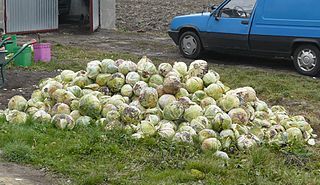From Guest Blogger Steve Waller: 3 Factors Contributing to Our Colossal Food Waste
According to a report released last week by the UK’s Institution of Mechanical Engineers (referred to as IMechE) as much as half of all the food produced worldwide goes uneaten. This already astonishing figure is thrown into even starker relief when it is considered that, according to the latest figures from the United Nation’s Food and Agriculture Organisation of the United Nation (FAO) as many as 870 million people (that’s 12% of the world’s population) are undernourished.
Whilst in the developing world, food waste is often down to imperfect farming practices, in the first world the poor use of the resources available to us is the chief problem. Here’s a look at three of the main factors that are helping to maintain this flawed system:
Food Retailer’s Selection Criteria
In recent years there have been positive moves made by big names across the food retail industry to include more ‘wonky’ produce among the fruit and vegetables that make it to our supermarket shelves. However, the fact remains that stringent standards enforced by buyers often mean producers are often unable to get retailers to take perfectly edible food off of their hands on the basis of its physical appearance.
To take one example, during his research into food waste Tristram Stuart, author of the book ‘Waste: Understanding the The Global Food Scandal’, visited a farm in Yorkshire and found that 25-30% of the carrots grown were ‘out-graded’ by the standards of the supermarket being supplied due to lacking a bright enough colouration or for having a bend in them. The IMechE report claims that in the UK 30% of all crops grown, aren’t even harvested due to cosmetic ‘defects’ whilst globally 1.6 million tonnes of good are thrown away on the same grounds.
Confusion Over Sell By Dates
In Europe and the US it is estimated that 30-50% of all the food a household buys are thrown away with overly cautious sell by dates combined with overbuying (spurred on by multiple buy promotions on fresh food) forming a large part of the cause.
Part of the problem is the confusion that arises from a failure to distinguish between ‘sell by’ dates and ‘use by’ dates. A 2010 study found that 76% of Americans believed that foods were unsafe to eat once the sell by date had elapsed. The US Department of Agriculture has found that, on a national scale, almost 30 million tonnes of food is thrown away whilst still perfectly edible. Meanwhile, a report by the Business Reference Panel found that in the EU the lettering of the law regarding use by dates means they are often inappropriate, and make no provision for the fact that many foods remain completely safe to consume even after their quality has deteriorated slightly.
Economic Oddities
Though for huge numbers of people all over the globe food is a scarce, highly valuable and absolutely vital resource, in industrialized countries capable of excessive production it is common for situations to arise in the process of production where it is cheaper to throw away dispose of unused food than to reuse it.
For instance, in most factories handling processed foods any products which are damaged or ‘inferior’ in anyway on reaching the end of the line are disposed of, both because it would be expensive for the company to implement systems to allow them to reuse these resources and, as consumers can easily avail themselves of affordable high quality food elsewhere, there’s an insufficient market for these ‘inferior’ goods. Consequently, they aren’t worth saving from landfill in a business sense.
Steve Waller (aka “Green Steve”) is an environmental blogger on a mission to reduce his carbon footprint and help others do the same. To this end he recently set up the Green Steve Shop, where you can purchase a huge range of goods whilst offsetting CO2 with every penny that you spend.


Just to clarify: I suspect that the only way 50% of the foods produced can go uneaten is if the ~30-40% of foods produced for the purpose of producing biofuels is counted.
I’m sure this is a problem and a significant waste, but I’m also sure that almost all of all food staples – the vast majority of the world’s foods – are harvested and sold. Cosmetics don’t matter on something that will be ground up into flour.
So we are wasting food, but we’re not throwing out half of what is grown because it’s ugly… most of our waste involves fermenting, distilling, and burning in a gas tank.
But it is sad that we throw out as much as we do.
I had the same reaction to this 50% figure, btw.